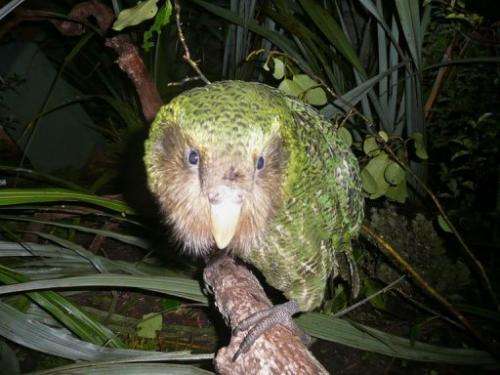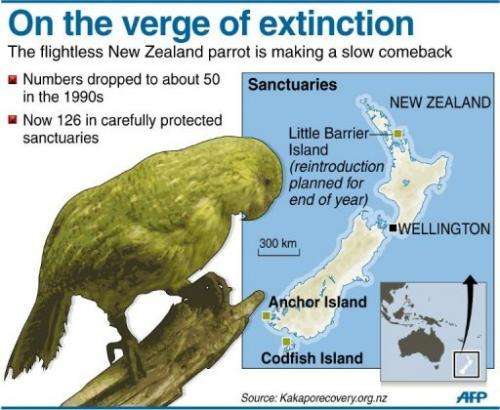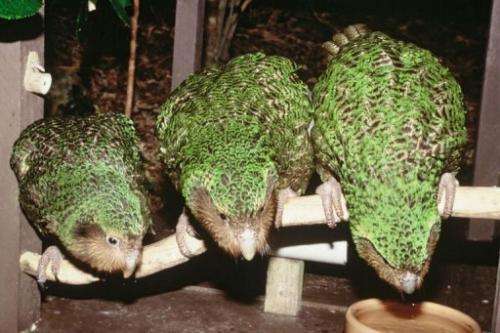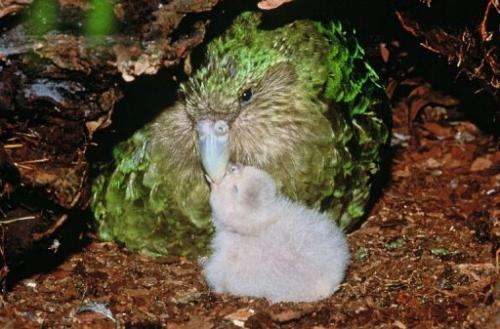N. Zealand's 'night parrot' brought back from the brink

Flightless, slow-moving and at times more sexually attracted to humans than their own species, it's small wonder New Zealand's kakapo parrot is on the verge of extinction.
But a mammoth conservation effort stretching back decades is offering hope for one of the world's rarest birds, lifting its numbers from about 50 in 1990 to 126 this year.
The plump, green kakapo -- the name means "night parrot" in Maori -- was once one of the most common birds in New Zealand, which had few land predators before European settlement in the early Nineteenth Century.
"There was a report from an early explorer, Charles Douglas, who said they were so populous you could shake them out of trees like apples," said Deirdre Vercoe Scott, head of the Department of Conservation's kakapo recovery programme.
"He said he'd once seen six kakapo shaken from a single tutu bush."
Vercoe Scott said habitat destruction by humans and the introduction of pests such as stoats and predatory cats and dogs, sowed the seeds of the kakapos' decline.
The flightless nocturnal birds, while essentially ground dwelling, are strong climbers but freeze when confronted by a threat, making them easy pickings for predators.

The males also attract mates by emitting a deep booming sound from thoracic air sacs, turning them into conspicuous targets for hunters in the night forest.
With an ageing population and bird numbers declining, kakapo recovery programme chief scientist Ron Moorehouse said the species' future appeared "dire" in the 1990s.
The situation sparked an intense conservation initiative, which has cost tens of millions of dollars, to save a bird that those who have encountered it describe as endearing and full of personality.
"They can be quite grumpy," ranger Sarah Kivi said. "They display so much personality, which I guess you don't get from a lot of birds. They'll sit there and look at you and you wonder 'what are they thinking?'".
Exacerbating the problem was the fact that kakapo, which can live up to 90 years, are notoriously slow breeders, only reproducing in seasons when abundant fruit is available from native tree species.

The breeding programme faced another hurdle when male kakapo became "imprinted" on their human handlers, meaning they saw them as more likely potential mates than female kakapo.
In the early days of the conservation effort, rangers even wore an outlandish rubber helmet dotted with dimples in an unsuccessful attempt to collect kakapo sperm when males tried to mate with their heads.
British actor Stephen Fry witnessed the kakapo's amorous antics first hand while filming his programme "Last Chance to See" in 2009, when a kakapo named Sirocco took a shine to zoologist Mark Carwardine and began vigorously coupling with his scalp.
The resulting footage, which Fry described as "one of the funniest things I've ever seen", attracted almost four million hits on video-sharing website Youtube www.youtube.com/watch?v=9T1vfsHYiKY.
Vercoe Scott said the birds' fortunes began to improve when they were moved to two remote islands where existing pests had been eliminated and which predators from the mainland could not reach by swimming.

"The biggest breakthrough was putting all the birds together on predator-free islands and understanding how they breed while getting over (our) fear of intervening," she said.
"If we'd taken a hands-off policy we would have lost the kakapo, so we really had to get in there and be quite intense with our management, particularly during the nesting period."
She added that her team set up cameras, weighed the chicks nightly and as a result hand reared many of the birds.
Vercoe Scott said it was highly unlikely any kakapo now survived in the wild, meaning only the conservation programme could save the species.
Such has been its success that rangers this year re-introduced eight kakapo to a third sanctuary, Little Barrier Island off the Auckland coast, after eliminating a rat infestation which forced their removal in 1999.
Moorehouse said some of the eight birds originally came from the island and immediately returned to their old nesting spots, raising hopes they will quickly settle in and breed in the new environment.
While the kakapo is still listed as critically endangered, Moorehouse said the situation no longer looked bleak.
"The trend is up, so we're encouraged by that," he said.
"We're certainly more comfortable, but with 126 birds you have to manage the genetics very carefully and that's what we're trying to do, so we retain as much genetic variation in the population as we can.
"So we're not out of the woods by any means but we're going in the right direction."
(c) 2012 AFP




















